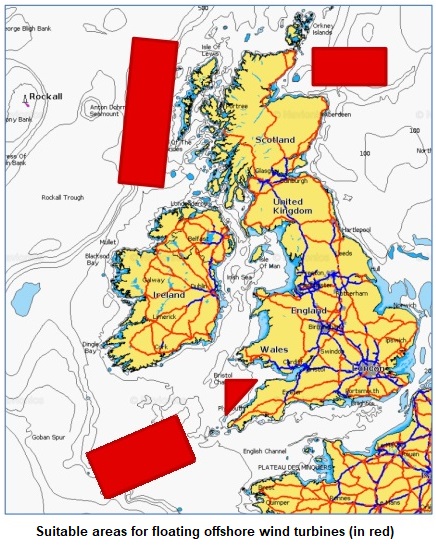You’re probably aware that offshore wind has featured heavily in the government energy policy of late, with it firmly behind a target of 40GW of offshore wind by 2030. Within that 40 GW target is 1 GW of floating offshore wind, and that’s really significant for us is in the South-West of England.
All offshore wind farms deployed in the UK so far have deployed turbines fixed to the seabed, in shallower waters. Although suitable sites using this technology do exist in the South-West, and in the past attempts to develop some sites progressed quite far, the Crown Estate (which leases out the sites) has since prioritised such new sites in other regions of the UK, and the South-West has missed out.
A good proportion of the above 40GW target is now already in operation, being built out, or under development. However, 40GW by 2030 is just a stepping stone. The Committee on Climate Change expects that if we’re to meet our 2050 net zero targets we’ll likely need over 100GW of offshore wind, with “50% + of the future portfolio yet to be identified”.
The sites ear-marked to provide the first 40GW are largely concentrated in the North-East, North-West, and East of England. There’s a danger of these areas becoming over-saturated, and from a grid-balancing perspective it makes sense to balance our wind capacity more evenly around the UK. So we should be looking further afield for the next 60GW, and this means using deeper waters such as the Celtic Sea – the area between Southern Ireland, West Wales and the Cornish coast. Here we need floating turbines. This technology is less well developed but has huge potential, because floating turbines in deeper water can access the best wind resources. And the good news is the majority of the world’s potential wind capacity is in these deeper waters, including the UK. The Celtic Sea itself has one of the best wind resources in Europe, and a recent report by Offshore Renewable Energy Catapult stated there could be as much as 50GW capacity available here.

Floating offshore wind (FLOW) had previously been uneconomic, but this is now changing as the technology rapidly develops. FLOW now needs to scale up in size and speed of deployment, and requires government support to do this. Much lobbying work has been done on this front over the past few years, and the current government target of 1 GW of floating wind by 2030 is the result of that effort. The target isn’t big enough, but it’s something to build on.
Just as importantly as the 1GW target , FLOW schemes have now been included in the government Contracts For Difference auctions for the first time, thereby providing a source of revenue support. Auction Round 4, due to run this year, is the first round to accept FLOW schemes.
This growing regulatory support for FLOW has provided the environment for developers to get to work on the first FLOW schemes in the Celtic Sea, and it’s exciting to see three projects already underway: The Wave Hub site off the Cornish coast is the first <30MW FLOW project in the South West, and is aiming to be part of CfD Auction Round 4. Meanwhile Blue Gem Wind is developing its 96 MW Erebus project 45km off the Pembrokeshire coast. It has already been granted a lease from the Crown Estate which has a support scheme for innovation projects under 100MW.
Blue Gem Wind had also begun to develop its second project, Valorous, a 300 MW scheme about 50 km South West of the Pembrokeshire coastline, and in March 2021 the Crown Estate announced it was beginning work on a leasing round in the Celtic Sea for FLOW projects of around 300MW in size.
This is a really significant moment. A leasing round of this size provides one of the key building blocks for the development of early commercial-scale floating wind projects in the Celtic Sea. We’re starting to glimpse how the South-West can really contribute to the UK meeting its net zero targets.

